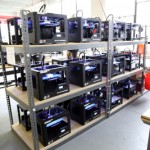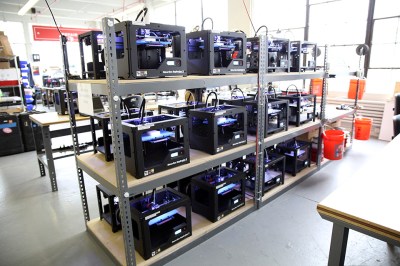

3D printing remains a nascent market, despite high levels of hype around the technology’s potential – such as, most recently, news that astronauts will be using a 3D printer in space next year. The hype may be a little overblown but there’s no doubting the technology’s trajectory. Enter analyst Gartner with a new report, which predicts worldwide shipments of sub-$100,000 3D printers will grow 49% this year, to reach a total of 56,507 units.
That rate of growth is forecast to rise to 75% in 2014, fuelling shipments of 98,065 units. It’s the first time Gartner has put together a forecast for the sub-$100,000 3D printer market so that’s something of a rite of passage for the technology too.
“The 3D printer market has reached its inflection point,” said Pete Basiliere, research director at Gartner, in a statement. “While still a nascent market, with hype outpacing the technical realities, the speed of development and rise in buyer interest are pressing hardware, software and service providers to offer easier-to-use tools and materials that produce consistently high-quality results.”
“As the products rapidly mature, organisations will increasingly exploit 3D printing’s potential in their laboratory, product development and manufacturing operations,” he added. “In the next 18 months, we foresee consumers moving from being curious about the technology to finding reasons to justify purchases as price points, applications and functionality become more attractive.”
The analyst expects the price of 3D printers to be driven down by competitive pressures and higher shipment volumes over the next several years, helped by increasing numbers of large multinational retailers selling 3D printers through their physical and online stores. By 2015 it’s predicting seven of the 50 largest multinational retailers will do so.
“Office superstore Staples is already in the market, and other superstores and consumer goods retailers, such as Yamada Denki, are prime candidates to sell printers and finished 3D printed items. Their presence in the market will have an impact on average selling prices, forcing providers into low-margin sales of consumer 3DP by 2017,” Basiliere added.
Combined end-user spending on 3D printers is predicted to hit $412 million this year, up 43% from spending of $288 million in 2012. While the analyst expects spending to increase 62% next year, reaching $669 million. Gartner’s forecast shows enterprises continuing to dominate 3D printer purchases over the next few years, with enterprises spending more than $325 million in 2013 vs $87 million in the consumer segment; and $536 million in 2014 vs consumer spending of $133 million.
Gartner noted that current enterprise uses of 3D technology focus on “one-off or small-run models for product design and industrial prototyping, jigs and fixtures used in manufacturing processes and mass customisation of finished goods”. But as advances in 3D printers, scanners, design tools and materials reduce the cost and complexity of creating 3D printed items, it said applications of 3D printing technology will expand further – drawing in other areas such as “architecture, defence, medical products and jewellery design”.
The analyst expects 3D printers to have the biggest impact on industries, including consumer products, industrial and manufacturing, and a “medium impact” on construction, education, energy, government, medical products, military, retail, telecommunications, transportation and utilities. Low impact industries include banking and financial services and insurance.
“Most businesses are only now beginning to fully comprehend all of the ways in which a 3DP can be cost-effectively used in their organisations, from prototyping and product development to fixtures and moulds that are used to manufacture or assemble an item to drive finished goods,” said Basiliere.
And while earlier buyers of 3D printers will continue to be makers and hobbyists, rather than average consumers, Gartner reckons the former group will contribute to the development of a 3D printing ‘killer app’ – some form of “plug and play” tool – that will be key to driving consumer sales in future. ”We expect that a compelling consumer application – something that can only be created at home on a 3D printer – will hit the scene by 2016," Basiliere added.
Source: Techcrunch.com